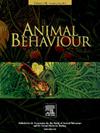Male forehead gland scent may encode multiple information in the great Himalayan leaf-nosed bat, Hipposideros armiger
IF 2.3
2区 生物学
Q2 BEHAVIORAL SCIENCES
引用次数: 0
Abstract
Intrasexual competition favours the evolution of pronounced individual identity and competitive ability badges. However, although olfactory signals play a role in territorial conflicts of many animals, the information content encoded in olfactory signals in the context of territorial conflicts is relatively unknown. Here, we used male great Himalayan leaf-nosed bats, Hipposideros armiger, to explore whether olfactory signals from the forehead gland encoded reliable information about a signaller's individual identity, physical condition, dominance status and physiological quality. We did this by using gas chromatography–mass spectrometry to quantify the chemical composition of the gland exudate and by examining the relationships between the proportions of 24 volatile compounds and physical condition (body condition index), dominance status (David's score) and physiological quality (immunocompetence, hormonal levels and resting metabolic rate). The results showed that there were significant differences in the concentrations and categories of compounds between individuals. Moreover, the proportions of many compounds correlated with David's score and neutrophil/lymphocyte ratio. Our results indicate that olfactory signals of H. armiger could transmit information about individual identity, dominance rank and physiological quality and may work as a reliable ‘chemical ornament’ for male–male competition.
雄性大喜马拉雅叶鼻蝠的前额腺气味可能编码了多种信息
雌雄之间的竞争有利于显著的个体身份和竞争能力标志的进化。然而,尽管嗅觉信号在许多动物的领土冲突中发挥作用,但在领土冲突背景下,嗅觉信号编码的信息内容相对未知。本研究以雄性喜马拉雅大叶鼻蝙蝠为研究对象,探讨了来自前额腺的嗅觉信号是否编码了有关信号者个体身份、身体状况、优势地位和生理品质的可靠信息。为此,我们使用气相色谱-质谱联用技术对腺体分泌物的化学成分进行了定量分析,并检测了24种挥发性化合物的比例与身体状况(身体状况指数)、优势地位(大卫评分)和生理质量(免疫能力、激素水平和静息代谢率)之间的关系。结果表明,个体间化合物的浓度和种类存在显著差异。此外,许多化合物的比例与David's评分和中性粒细胞/淋巴细胞比率相关。结果表明,棉铃虫的嗅觉信号可以传递个体身份、优势等级和生理品质等信息,是雌雄竞争中可靠的“化学装饰”。
本文章由计算机程序翻译,如有差异,请以英文原文为准。
求助全文
约1分钟内获得全文
求助全文
来源期刊

Animal Behaviour
生物-动物学
CiteScore
4.60
自引率
8.00%
发文量
236
审稿时长
10.2 weeks
期刊介绍:
Growing interest in behavioural biology and the international reputation of Animal Behaviour prompted an expansion to monthly publication in 1989. Animal Behaviour continues to be the journal of choice for biologists, ethologists, psychologists, physiologists, and veterinarians with an interest in the subject.
 求助内容:
求助内容: 应助结果提醒方式:
应助结果提醒方式:


